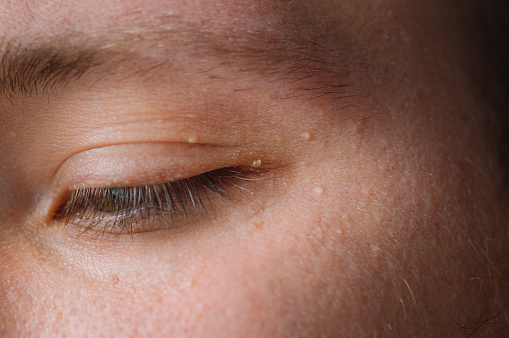What are Skin Tags?
A skin tag or acrochordon is a small benign tumor that forms in areas where the skin forms creases (or rubs together), such as the neck, armpit, and groin.
They may also occur on the face, usually on or nearby eyelids.
Skin tags are very common and generally occur after midlife. They affect men and women equally.
They consist of a core of fibers and ducts, nerve cells, fat cells, and a covering or epidermis. They often go unnoticed, unless they are in a prominent place or are repeatedly rubbed or scratched, for example, by clothing, jewelry, or when shaving.
Some people may have skin tags and never notice them. In some cases, they rub off or fall off painlessly. Very large skin tags may burst under pressure.
The surface skin tags may be smooth or irregular in appearance. They are often raised from the surface of the skin on fleshy peduncles, or stalks. They are usually flesh-colored or slightly brownish.
Skin tags start small, flattened like a pinhead bump. Some stay small, and some grow bigger. They can range in diameter from 2mm to 1cm, and some may even reach 5cm.
Treatment of Skin Tags
As skin tags are usually harmless, removal is normally for aesthetic or cosmetic reasons. Large skin tags, especially in areas where they may rub against something, such as clothing, jewelry, or skin, may be removed due to irritation.
Removing a large skin tag from the face or under the arms can make shaving easier.
Surgery
The following procedures may be used:
- Cauterization: The skin tag is burned off using electrolysis.
- Cryosurgery: The skin tag is frozen off using a probe containing liquid nitrogen.
- Ligation: The blood supply to the skin tag is interrupted.
- Excision: The tag is cut out with a scalpel.
These procedures should only be done by a dermatologist, or specialist skin doctor, or a similarly trained medical professional.
Skin tags on the eyelid, especially those close to the eyelid margin, may have to be removed by an ophthalmologist, or specialist eye doctor.
Removing a skin tag at home is not normally recommended, due to a risk of bleeding and possile infection.
Over the Counter Solutions
Over-the-Counter (OTC) solutions are available at pharmacies. These freeze the skin tag, and it will fall off after 7 to 10 days. These may also be purchased online, although it is recommended that professional medical advice is sought before using these treatments.
These medications are similar to those used for wart removal. There is no evidence that removing skin tags encourages more of them to develop.
Causes
It is not clear exactly what causes skin tags, but it may happen when clusters of collagen and blood vessels become trapped inside thicker pieces of skin.
As they are more common skin creases or folds, they may be mainly caused by skin rubbing against skin. Some people appear to inherit an increased susceptibility to skin tags.
Skin tags affect both males and females, but they happen more often during pregnancy, in people who are obese, and in people with diabetes. They have been associated with hyperinsulinemia when there is too much insulin circulating in the blood.
Risk factors for skin tags
Skin tags appear to be more common in:
- People who are overweight and obese.
- Those with diabetes
- Women during pregnancy, possibly due to hormonal changes and high levels of growth factors.
- Those with some types of human papillomavirus (HPV).
- People with a sex-steroid imbalance, especially if there are changes in levels of estrogen and progesterone.
- Those whose close family members also have a skin tag.
References;
1. Skin Tags
by Dr. Suhul Dhar
Tue, 20 Sep 22 06:46:03
Topics
Jammu & Kashmir - History, Culture & Traditions | J&K Current Trends | Social Network | Health | Lifestyle | Human Resources | Analytics | Cosmetics | Cosmetology | Forms | Jobs
Related blogs
How much time does it takes to get tan?
Here is what you need to know about tanningWhy is India a Growing Market for Beauty Startups?
While Covid-19 did impact the people, brands and...How to make a skin cream?
It just needs some knowledge of ingredients, and...Have you ever tried Dead Sea Cosmetics?
Dead Sea is very famous sea located between...
Quote of the Day
"Time Flies Over, but Leaves its Shadows Behind"



